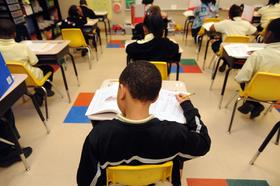Top Rankings
Franklin County Schools School District ranks among the top 20% of public school district in North Carolina for:
Category
Attribute
Diversity
Most diverse schools (Top 1%)
Community Size
Largest student body (number of students) (Top 1%)
For the 2025 school year, there are 4 public high schools serving 2,834 students in Franklin County Schools School District. This district's average high testing ranking is 6/10, which is in the top 50% of public high schools in North Carolina.
Public High Schools in Franklin County Schools School District have an average math proficiency score of 64% (versus the North Carolina public high school average of 58%), and reading proficiency score of 53% (versus the 58% statewide average).
Public High School in Franklin County School School District have a Graduation Rate of 83%, which is less than the North Carolina average of 86%.
The school with highest graduation rate is Franklin County Early College, with ≥90% graduation rate. Read more about public school graduation rate statistics in North Carolina or national school graduation rate statistics.
Minority enrollment is 62% of the student body (majority Black), which is more than the North Carolina public high school average of 55% (majority Black and Hispanic).
Overview
This School District
This State (NC)
# Schools
16 Schools
761 Schools
# Students
7,978 Students
565,764 Students
# Teachers
525 Teachers
33,453 Teachers
Student-Teacher Ratio
15:1
15:1
Student By Grade
District Rank
Franklin County Schools School District, which is ranked within the bottom 50% of all 320 school districts in North Carolina (based off of combined math and reading proficiency testing data) for the 2021-2022 school year.
The school district's graduation rate of 83% has decreased from 86% over five school years.
Overall District Rank
#205 out of 325 school districts
(Bottom 50%)
(Bottom 50%)
Math Test Scores (% Proficient)
(21-22)46%
51%
Reading/Language Arts Test Scores (% Proficient)
44%
50%
Science Test Scores (% Proficient)
59%
63%
Graduation Rate
(21-22)81%
86%
Students by Ethnicity:
Diversity Score
0.71
0.70
% American Indian
n/a
1%
% Asian
1%
4%
% Hispanic
26%
20%
% Black
31%
24%
% White
36%
45%
% Hawaiian
n/a
n/a
% Two or more races
6%
6%
All Ethnic Groups
District Revenue and Spending
The revenue/student of $11,621 is higher than the state median of $11,187. The school district revenue/student has stayed relatively flat over four school years.
The school district's spending/student of $10,978 is less than the state median of $11,612. The school district spending/student has stayed relatively flat over four school years.
Total Revenue
$93 MM
$17,307 MM
Spending
$88 MM
$17,964 MM
Revenue / Student
$11,621
$11,187
Spending / Student
$10,978
$11,612
Best Franklin County Schools School District Public High Schools (2025)
School
(Math and Reading Proficiency)
(Math and Reading Proficiency)
Location
Quick Facts
Rank: #11.
Franklin County Early College
(Math: ≥80% | Reading: ≥90%)
Rank:
Rank:
10/
Top 5%10
8150 Nc Highway 56
Louisburg, NC 27549
(252) 738-3649
Louisburg, NC 27549
(252) 738-3649
Gr: 9-13 | 171 students Student-teacher ratio: 29:1 Minority enrollment: 57%
Rank: #22.
Franklinton High School
(Math: 70-74% | Reading: 51%)
Rank:
Rank:
8/
Top 30%10
910 Cedar Creek Road
Franklinton, NC 27525
(919) 494-2332
Franklinton, NC 27525
(919) 494-2332
Gr: 9-12 | 1,218 student Student-teacher ratio: 18:1 Minority enrollment: 62%
Rank: #33.
Louisburg Magnet High School
Magnet School
(Math: 50-59% | Reading: 50-54%)
Rank:
Rank:
6/
Top 50%10
201 Allen Lane
Louisburg, NC 27549
(919) 496-3725
Louisburg, NC 27549
(919) 496-3725
Gr: 9-12 | 585 students Student-teacher ratio: 17:1 Minority enrollment: 69%
Rank: #44.
Bunn High School
(Math: 50-54% | Reading: 45-49%)
Rank:
Rank:
6/
Top 50%10
29 Bunn Elem School Road
Bunn, NC 27508
(919) 496-3975
Bunn, NC 27508
(919) 496-3975
Gr: 9-12 | 860 students Student-teacher ratio: 18:1 Minority enrollment: 57%
Recent Articles

Why Single-Sex Public Schools are Growing in Popularity
This article examines the growing trend of single-sex public schools in the United States. It explores the potential benefits, research findings, and controversies surrounding gender-specific education, as well as the factors driving its increasing popularity among parents and educators.

When Teachers Cheat: The Standardized Test Controversies
Teachers across the country are being accused of cheating on standardized tests, using erasers to conveniently change their students’ answers. However, are these teachers driven to cheat because the funding system is flawed?

When Field Trips Turn Deadly: Who is Responsible?
Recent deaths during field trips have parents and school officials questioning the safety of these excursions. Learn about these tragedies and what parameters should be in place to ensure a safe field trip.





